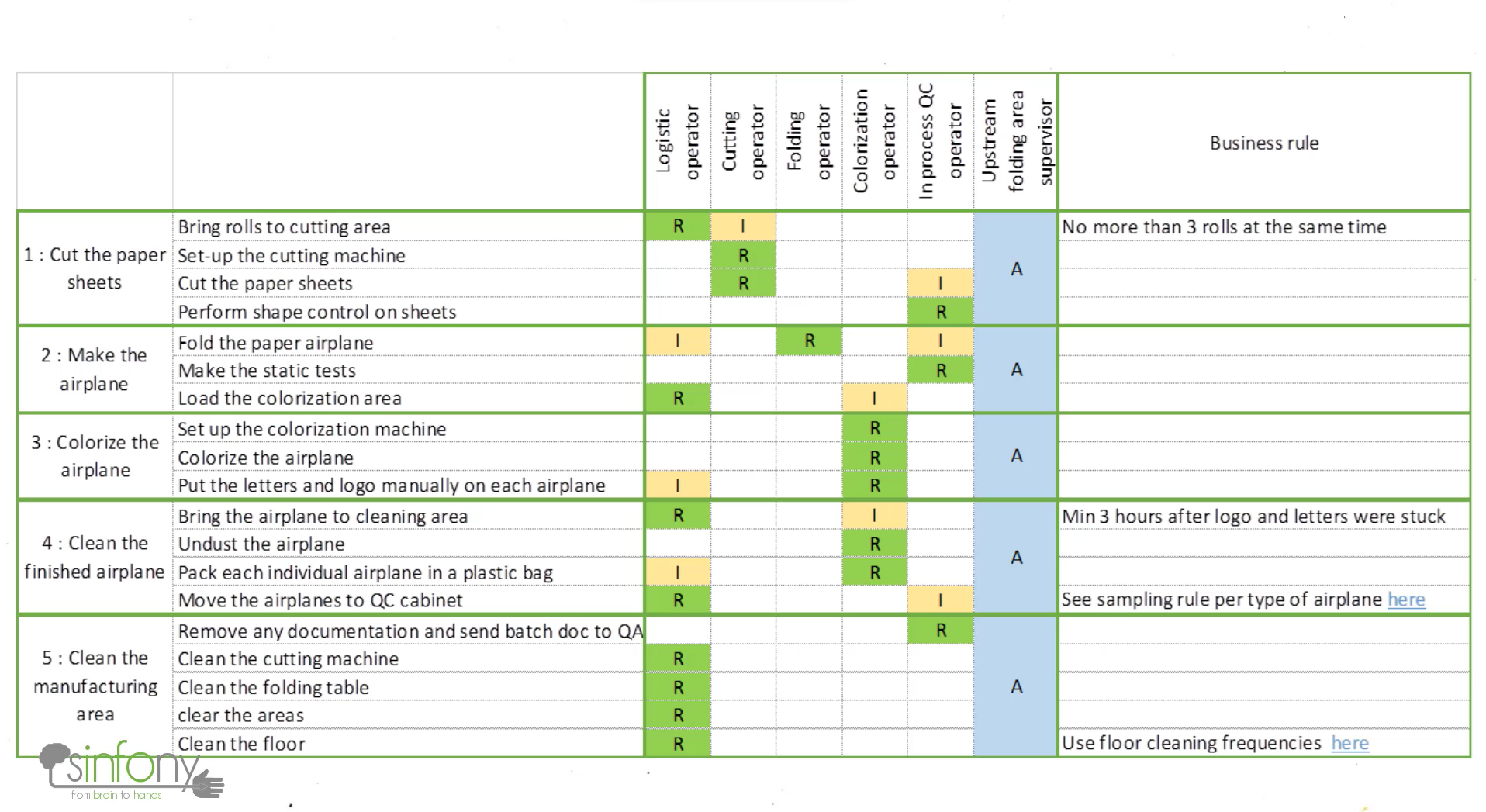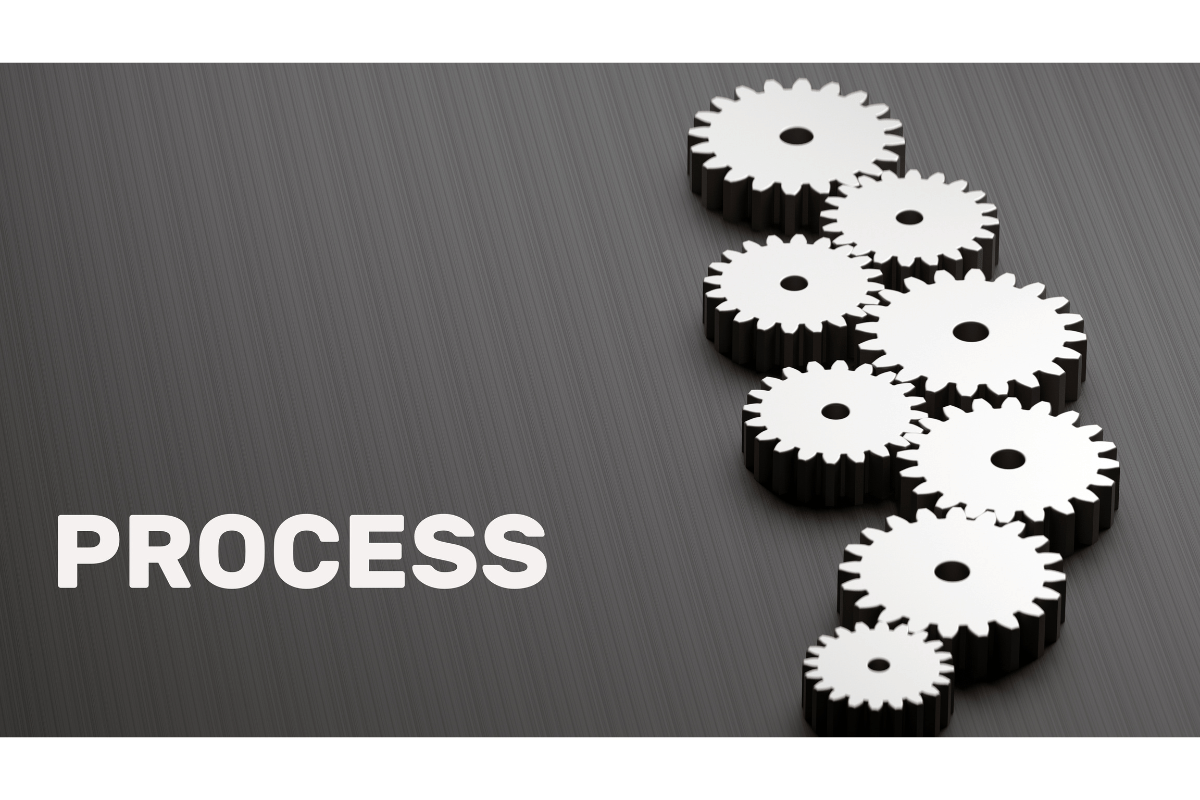July 28, 2025
The RACI matrix is a key project management method that helps you understand who is doing what on a project, or in a process. This way you can ensure that deadlines are met and that everyone knows their responsibilities. By defining the specific tasks and functions of each participant in the project or process, the matrix makes it possible to avoid confusion and to optimize communication.
RACI is an acronym in English for Responsible, Accountable, Consulted, Informed. If one had to translate the RACI matrix In French it would be:
For example, let's say you're tasked with creating a marketing campaign. You can create a RACI matrix with the following columns:
Responsible : the person who executes a task in the marketing campaign.
Accountable : the person who is committed to the result of the campaign, and who will be penalized if the campaign is a failure.
Consulted : the person who should be consulted on the task, for example, an SEA expert or an SEO expert who can be involved in the marketing campaign.
Informed : A person who needs to be informed that a task is finished, and that they can do their task. For example, in the marketing campaign, the media buyer should be informed that he can set up the ad when the graphic designer has selected the image.
A RACI matrix generally takes the form of a table, with the various tasks listed on the left and the different roles at the top. The cells in the table then contain information about the specific role of this task.
Example of RACI matrix (or RACI table):

Note: we also sometimes talk about a RASCI matrix in which the “S” stands for “support”. This is the person who helps with the completion of a task. We think that this role is played by a C, or that if a medium intervenes, it is to execute a task, and therefore that it is better to make this task appear, with an R. We will therefore keep the RACI acronym in this article.
When creating a RACI matrix, it is important to keep the following in mind:
1. Be firm : a RACI matrix is used to establish clear and unambiguous roles and responsibilities. It is an increase in productivity in your processes or in the success of your projects. That means you need to be tough on applying the best RACI practices described later in this article.
2. Be realistic : the matrix should reflect the reality of the project and the abilities of the team members. Don't add unnecessary tasks or roles just because they look good on paper.
3. Work as a team : establishing a RACI is a compromise between several points of view. It is also a reflection of organizational decisions taken by managers of departments, business units, or others. Doing a RACI alone in your office inevitably leads to failure. Doing a RACI in a working group is faster, and relying on the best practices presented in this article makes it possible to succeed every time.
4. Use plain language : use the simplest texts possible. You will see in RACI's best practices in this article that everything is done to avoid confusion and uncertainty.

1. First define the process which the RACI is supposed to rely on. A RACI does not exist without a process. You must first describe the boundaries of the process (start/end), the steps of the process, and for each stage of the process, the activities. You need to have business continuity or tasks within the process from start to finish.
2. Define the roles involved in the process. You'll see in the RACI best practices in this article that some of them apply to role definition.
3. Define responsibilities at the intersections of tasks and roles. We're talking here about putting the R's, the A's, the C's, and the I in the right places. And you need to be very thorough in applying the RACI best practices written in this article.
4. Use the “business rule” area to provide additional information on a task, or make a reference to an attached document.
5. Review RACI with decision makers (usually the “A”). They need to be aware of, and support, the division of responsibilities in the process. If they disagree, they have to say it, and then they have to give their vision. But be careful, when they give you their vision, modify the RACI by applying the 9 best practices of RACI matrix.

Now that we know how to create a RACI matrix, let's look at the common mistakes to avoid:
1. Wanting at all costs to fill in all the boxes in the RACI matrix. This is a very common error. The author of RACI absolutely wants to fill in all the boxes believing that he will remove all ambiguity. But in fact, it makes the RACI matrix completely unreadable. And responsibilities that are assigned in a completely artificial way. Only relevant responsibilities should be fulfilled.
2. Work alone and impose the result. As mentioned earlier in this article, building a RACI matrix alone takes you into the wall. Making a RACI matrix is technically simple. You'll see the 9 RACI best practices in this article. But above all, think that writing a RACI matrix is above all about finding an agreement on the distribution of roles and responsibilities in a project or in a process. It is therefore a form of contract between all the actors.
3. Showing yourself weak and accepting a soft consensus. This error nips RACI in the bud and completely misses its purpose. Accepting R 2 per task means accepting that you don't know who is doing what. Accepting a general “team” role means refusing to give power to someone specific. Making a clear RACI requires managerial courage and firmness, while remaining courteous.
4. Confusing responsibilities. When you do a RACI, many people working with you will lack courage, or will want to develop “big brother” roles, by hiding responsibilities. You are going to have false “I” s, or false “Cs”, which actually hide R's, or even A. If you let yourself fall asleep by these people, your RACI may miss its purpose once again. The salvation lies in the 9 RACI best practices described in this article.
You understood it if you read this article carefully from the beginning... Anyone can do a RACI. Numerous articles and tutorials explain it to you.
But doing “THE RIGHT RACI”, the one that removes all ambiguity about roles and responsibilities, is not for everyone.
Only an author who is aware of possible biases, and courageous in the face of his colleagues will be able to achieve his goals.
So now let's go into detail about these best practices on “how to write a RACI matrix”.
Find the complete practice here: https://youtu.be/pdbiKAPGgPc

A RACI should guide the reader. Responsibilities should be easily identifiable.
The problem is in what order these responsibilities should appear.
The easiest way is to put the tasks into the RACI matrix in the same order as in the process.
You can use a Business Process Management tool to describe your processes, or even your project process.
These Business Process Management tools manage RACI in general.
But graphically, it's not very beautiful.
For your first RACIs, use a good old Excel table, it works just as well at the beginning.
Put your process steps and tasks in chronological order, in the left columns of your RACI.
Take a look at the RACI matrix example earlier in this article how we represented process steps and tasks. Now here are 3 tips to make your RACI matrix easy to read.
If you have the same responsibilities, for all the tasks in a process step in your RACI matrix then you should go up the responsibilities to the level of the process stage and do a single line.
It's exactly the same when consecutive tasks have the same responsibilities in a process step.
To make it clear what's inside, name the task group correctly.
A complex process can contain numerous roles and steps, which can make it difficult to read the RACI matrix.
To simplify reading, it is advisable to divide the RACI matrix into several parts (RACI sub-matrices), each corresponding to a specific phase or group of steps.
This will reduce the length of each part and reduce the number of roles.
In this way, the matrix will be more readable.
It is important to maintain the chronological order of RACI submatrices to avoid confusion.
Some may believe that the RACI matrix is incompatible with parallel activities, but that is not true.
By using a graphical view (flowchart) of activities, it is possible to identify parallel activities in the RACI matrix.
It is important to respect the wording of the flowchart activities so that the reader can find their way around.
It is also possible to specify in the comments to the RACI matrix that certain activities must be carried out simultaneously.
Find the complete practice here: https://youtu.be/qiaooCUDIR8

A poorly defined, or too general, role in the RACI matrix, and the whole process goes awry or becomes inapplicable.
There is no point in defining roles in a RACI matrix if it is to leave a blur and avoid the sensitivities of the less courageous department managers.
While well-defined RACI roles, it is an opportunity to allocate the right responsibilities, at the right level without ambiguity.
A role must be attributable to someone who is clearly identifiable in the organization.
This means that a role cannot refer to a team, let alone a committee.
A role can target a position in the organization (subject to a job description), or better, must have very clear wording in the process concerned.
For example, in the deviation process:
Always ask yourself the question of possible ambiguity about roles, and be as clear as possible. Now here are 3 tips for clarifying the roles in your RACI matrices.
It is essential to define roles precisely in RACI matrices using job titles or individual names rather than generic team or function names.
This way you will know exactly who is responsible for what and you can contact them directly.
It is therefore recommended to use roles that represent organizational positions for better clarity.
It is important to clarify roles using only one role per column to avoid uncertainty about decision, task execution, and responsibility.
You need to have the courage to clarify roles to avoid ambiguity and to avoid chance.
In your RACI, setting a specific role for each task is one of the biggest flaws.
This can cause difficulties in managing employee skills and require additional documentation to establish organizational correspondence.
It is better to define roles according to the skills required rather than to separate them according to the types of tasks.
So you will be able to:

Yes yes, you read that right!
I already touched on the subject a little bit higher in this article.
Who said you had to fill in absolutely all the boxes in a RACI matrix?
Nobody!
Look at examples of RACIs where everything is full, we don't understand anything!
Knowing how to fill out a RACI matrix starts with knowing how to sort out what is relevant and what is not.
If you have a RACI with 8 roles and 30 tasks, it is very very unlikely that all 8 roles should have RACI responsibility for all tasks.
So allow yourself to leave empty boxes. And put only the relevant responsibilities.
So you know that you can leave empty boxes.
On the other hand, for the boxes you fill in, you should only put one and only one responsibility not box.
Putting several responsibilities in the same box is tantamount to putting ambiguity into the RACI table.
Putting only one letter per box requires clear responsibility.
This is the only exception that allows you to have 2 letters in the same RACI box.
Take the “Building the Foundations” stage in the process of building a house as an example.
The surveyor is “R” to set up the demarcation chairs.
The digger is “R” to make the hole.
The mason is “R” in scrap metal.
The architect is “R” to check the layout and the reinforcement before casting.
The mason is “R” to pour concrete.
But overall, the architect is “A” for the foundations to be compliant and in the right place. He is “A” throughout the foundation construction stage.
And so for the “check before pouring” task, there are “R” and “A” in the same box.
Find the complete practice here: https://youtu.be/Gp2HWqaJgtc

The manager is the person who actually does the work and does each task. It could be you or another member of the team.
If you've ever found yourself in a situation where someone says, “I didn't know it was my turn to do that,” read on because I'm going to show you how to avoid this problem in the future. By clearly defining responsibilities, everyone will know what their role is and no one will step on the sidelines of others. It also eliminates the risk of some tasks not being completed because no one realized they were responsible for them.
It can be tempting, when writing a RACI diagram, to put two “Rs” on the same line. For example, let's say two people need to approve a document. In this case, you will put an “R” for quality assurance and an “R” for business next to the document approval task.”
Another example: if two operators need to complete a task together, you would write 2 Rs.
However, the problem is that the responsibility is diluted. Neither operator feels obligated to complete the task successfully since they can pass the ball to each other.
You end up with a RACI chart which is doing more harm than good at this point (and that's just not the point).
The “R” in RACI means responsible. This is the person who is doing the task. In terms of approving a document, these would be two separate tasks, as two people are needed. The business person would approve the consistency of the content while the quality manager would approve compliance with standards and legislation.
Although they are both required for approval, they are two different tasks.
To prevent future confusion, I am going to share with you 3 important points for showing courage, assigning responsibilities, and creating clear procedures.
It's not easy, but it's the only way to have clear responsibilities. The most difficult example is committees, which are simply a group of people making a decision. So the task is “make a decision,” but since there should only be one R per task (the contributor), we need to figure out who that “R” is. This is where you need to empower someone to ensure that decisions are finally made. That's the whole point of having a single “R”.
If you want to put multiple Rs on one line, it means that your tasks are not detailed enough. For example, if there is an empty line. This is sometimes difficult to do, because you need to know the details of the tasks to be done. But this is not always the case when drafting a procedure. Sometimes people prefer to write a vague task rather than take the time to write a specific procedure. I say no to that! You have to go see what people are really doing.
It's easier for people to leave something loose than to accept responsibility, so stay brave.
You will have to fight often against those who find a thousand reasons to put two “Rs” on a line.
Find the complete practice here: https://youtu.be/nCyCF0LDk3Y

As mentioned above, Accountable is the guarantor of the perfect completion of the task or group of tasks. And it's up to you if something ever goes wrong.
He is the architect in the example of the foundations that I mentioned just before...
However, I agree, it is not always easy to determine who is accountable. Here are 3 tips for doing it right.
The scope of the accountable is a group of tasks that allows a large deliverable to be completed.
In my history of home foundations, the architect is fully accountable for all the activities that make it possible to have the foundations in accordance and in the right place.
It is true that being “accountable” is a big responsibility.
However, everything will work much better with properly defined A's, because you will have one single person who will really care about getting the whole thing done.
Your manager must have decision-making power and must be able to influence the people who do the work.
Of course this is not always easy, because you will have to convince people who are more concerned with politics and appearance than with moving the lines and making processes efficient.
You should always ensure that the accountable person is the most impacted by the completion of the project. In my swimming pool story, it is the architect that I would not have paid for if the pool had not been built correctly and in the right place.
Often, the person who is most impacted is at the end of the process.
She is the one who has to deal with all the problems that arise along the way and must justify the misadventures.
Find the complete practice here: https://youtu.be/cB548FcJVLo

The “C” for “consulted” in your RACI matrix means that this person should be consulted about the task at hand.
This person can make a valuable contribution and help ensure that the task is successful.
The use of Cs in the RACI matrix can help show a one-time contribution of expertise. This can be useful when there is a need for specific knowledge or skills.
By using the Cs, you can ensure that the stakeholders in the process (or members of a team in the context of a project) are able to work together effectively.
If you have an R who needs to perform a task (such as writing a report), then a C role can step in and help with the structure of the report (or provide feedback on the technical content of the report). It all depends on the role. I could even have two C roles, one to give advice on structure, the other on substance.
But sometimes, I have a C role on half of the RACI tasks!
Is this string of C really representative of expertise?
Imagine two people who need to approve the report. One is a business approver and the other a quality approver. The best way to do this is to create two lines in the RACI chart. One line is intended to “Approve the consistency and technical veracity of the report.” This means that the operational manager is responsible for approving it. The other line is for “Approve the regulatory compliance of the report” this means that the quality manager is responsible for approving it.
Some people might say that adding lines is a bad thing because it makes RACI harder to read. But it's worth it, because it makes it much easier to understand who is responsible for what and who agrees to do what. If you are using the RACI system, it is important that responsibilities are clear, otherwise there is no point in this system.
It's a great filter!
In the comment column, or “business rules”, or “management rules”, if you are not able to write in 10 words the nature of the C's expertise, it is because you are certainly in the presence of a disguised R, or even an A.
In this case all you have to do is clarify that.
Find the complete practice here: https://youtu.be/_s9FastW_ig

Les RACI charts are perfect for writing procedures.
But I noticed that sometimes a column only contains “I” for “informed.”
Recently, this happened to me while reviewing an audit procedure. The quality committee was informed of everything, and the column only contained “I's.”
In other words, someone is watching you all the time: “big brother is watching you.”
Let's see together in 3 points the good use of the “I” in RACI matrices.
The “I” in RACI is like a stick that is passed between the runners in a relay race.
They're not the coach's twin girls.
The “I” stands for “informed.” This means that the person in this role knows that the task is complete and that they can now start their own task.
In the case of the audit procedure, for example, the person responsible for creating the audit program must send it to several other people for approval.
The quality manager will ultimately be responsible for this task, but various roles must first validate the audit schedule. Once approved, the auditor should be informed that they can start preparing for the first planned audit.
Therefore, we will give them an “I” in the “validate the calendar” task. The “I” represents a transmission of information - it's essentially giving them the “green light” to move on to the next task.”
Some people will try to get you to put the roles into a column that's almost entirely filled with I.
But don't do it!
The people who want you to do that have the problem of wanting to control everything. Explain gently to them that a procedure supporting a process is not the same as a reporting schema.
If you use the I to give a GO, then you have a great opportunity when you do a RACI. You can use it to change all the automatic notifications from your computer systems. Put automatic notifications only for the I you put in the RACI. This way, your teams will receive fewer automatic emails and the ones they receive will be more relevant to them.
Find the complete practice here: https://youtu.be/H0FijXuCd5M

Every process requires collective decision-making by a group of people at certain times.
This group of people is often grouped together in a “decision committee.”
And the classic mistake is to put this committee into a role in the RACI.
I say error because the problem is that we don't know who the “committee” is.
Setting up a committee is contrary to good practice No. 2 on the non-ambiguity of roles.
“Committee is like “Team”, you cannot identify a specific person.
Committees should therefore be considered as several people who come together to “decide” something. Members must perform the task of “deciding to.”
And if we apply the best practices concerning R and A, as with any task, I must have one and only one R and one A on this “decide to” task.
And as with any task, you can define several “Cs” that provide informed advice.
And that's where the difficulty starts, but where responsibilities really get clearer.
You need to define:
This last practice is for managing tasks that can be performed by multiple roles in a process.
For example, in a restaurant, there is the task of performing the dive.
One evening, the diver is ill and cannot be there.
The restaurant owner has no choice but to do the dive himself. Because the cook doesn't have time, and the waiters don't know how to do it.
So the question is “does the owner of the restaurant have the right to do the dive”?
In the RACI, should I put R for the boss and R for the diver on the dive task?
No, obviously, because you can't put 2 R's on a line.
You can handle this case in two ways:
There is no perfect solution.
You need to discuss as a team how you are going to deal with the case if it occurs.

La RACI matrix is a good tool to use when you need to make sure everyone knows what tasks they are responsible for, as long as you apply the 9 RACI best practices mentioned in this article.
By using a RACI matrix, you can avoid confusion and ensure that everyone knows who is doing what in the process or in the project.
Additionally, using a RACI matrix can help streamline communication between stakeholders.
Here I leave you my 7 final tips for using RACI matrices effectively:
1. Keep it simple, but be rigorous and courageous.
2. Use a RACI matrix to Clarifying roles and responsibilities in the process or in your project.
3. Make sure everyone understands their role.
4. Make sure RACI corresponds to the reality of the tasks to be carried out. This will ensure that everyone is on the same page when it comes to expectations and responsibilities.
5. Use a RACI matrix as an effective tool for communication, of collaboration And of decisionmaking within your organization.
6. Update your RACI matrix regularly. This will allow you to ensure that it remains an effective and relevant tool for your team.
7. RACIs can be digitized very well with a Business Process Management tool. Try these tools!
Share this article with your teams who are in charge of documentation and training. Let them know that using the RACI matrix is a great way to convey information, improve communication, and get things done more effectively.
If you are passionate about the subject then you can access some of the free on our website. our DOC&training simplification training.
Des formations conçues par des experts métier, régulièrement mises à jour pour coller aux exigences terrain. Découvrez nos modules les plus suivis et les mieux notés par les professionnels.

Formation complète sur les Bonnes Pratiques de Fabrication (BPF) adaptée à votre profil professionnel dans l'industrie pharmaceutique et vétérinaire.

Maîtriser les techniques et les procédures essentielles.

Les procédures essentielles d'hygiène et de sécurité pour le personnel...